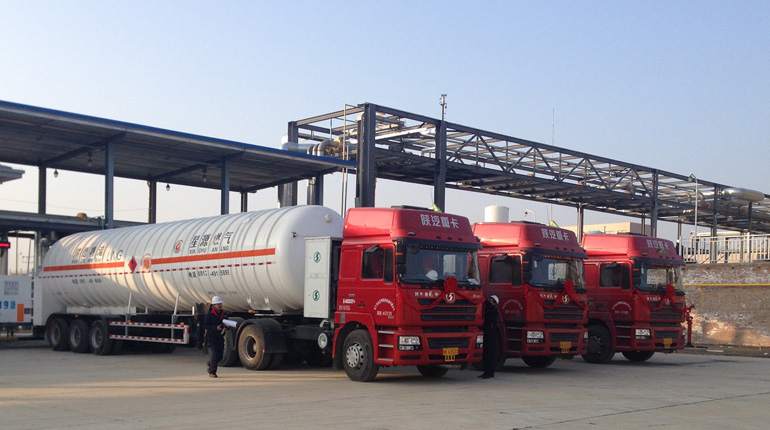 Costs for operators of LNG-fuelled vehicles have risen under the new rules. (Chemtex)
Costs for operators of LNG-fuelled vehicles have risen under the new rules. (Chemtex)
A crackdown by Chinese authorities in the past month on overloaded lorries and trucks has eroded the economics of LNG-fuelled haulage and curbed demand for the fuel in the transport sector.
The Chinese transport ministry began enforcing stricter weight limits for commercial vehicles on 21 September. The new regulations stipulate that a truck and the goods it carries cannot weigh more than 49 tons combined, down from a previous maximum of 55 tons, while trucks heavier than 100 tons must apply for a licence from local authorities.
Logistics operators using LNG-fuelled vehicles have been hit by rising costs under the new rules. LNG trucks are around half a ton heavier than diesel versions because of their fuel storage cylinders, which can weigh 350 kg each when filled. They must now carry less cargo to stay within the new weight limits.
Overloaded trucks will be fined up to RMB 30,000 ($4,500) depending on how much they exceed the weight limit by, while drivers can be punished with six points deducted from their licence.
"The regulation has impacted our LNG fleet," said a general manager at a logistics firm in Shandong province that transports industrial goods such as iron and steel.
"The new weight restrictions mean more trips are required to deliver the same amount […] Trucking a single ton of freight is now more costly for us," the manager told Interfax Natural Gas Daily on condition of anonymity.
Transport costs for the company’s LNG trucks have doubled for distances within 300 km, while trips exceeding 1,000 km are costing 25-30% more than before, said the manager. The company is still running its LNG fleet for now.
The new weight limits have been strictly enforced, with inspections in cities ramped up to prevent trucks from being overloaded, according to SCI International analyst Liu Guangbin. "It is good to secure cargo transport but it has impacted the LNG transportation companies and the downstream market," Liu told Interfax Natural Gas Daily.
Vehicle overloading is a common offence in China, with passenger vehicles as well as trucks tightly packed to save on costs. In one case in January, an overloaded truck caused the road beneath it to collapse, forming a sinkhole that swallowed the back end of the vehicle.
Drop in demand
The higher expense is weighing on interest in LNG trucks and has curbed demand for the fuel in some markets. Daily sales at one LNG filling station in Jinan, capital of Shandong, halved in the first week of the new rules, the station manager told Interfax Natural Gas Daily. He said some logistics operators in Jinan stopped using LNG vehicles altogether shortly after the regulations kicked in.
The softer LNG sales have lowered delivery rates for the fuel in some regions. In south China, transport costs of LNG by diesel truck dropped by 9.3% in the first two weeks of October, from the last two weeks of September, according to data from SCI International. In the north, transport costs by LNG-fuelled trucks fell by 8.9% over the same period.
The logistics firm manager in Shandong said the higher transport costs had not affected margins for now, as customers were covering the increase. He added he would not idle his LNG fleet even if they began to drag on profits, as environmentally friendly fuels will become more popular.
Winter supply
Liu projected LNG delivery rates will increase this winter on the back of tight gas supply. China’s gas supply gap this quarter could reach the equivalent of 4.50 mt of LNG, but supply from domestic plants and terminals would only be able to cover 3.48 mt, leaving a shortfall for Q4 of 1.02 mt – equivalent to 568 truckloads of LNG per day.
"Prices will increase significantly as demand tightens, followed by delivery rates," said Liu. The station manager agreed, and said he had inquired about the cost of trucking LNG from Xinjiang to his station in Shandong – a distance of more than 2,000 km.
"Some providers quoted me a charge of RMB 0.55-0.60 per ton per km for November, compared with RMB 0.50-0.53/t/km at present," he said.
Firmer LNG buying for the coming heating season has already pushed up delivery rates in some markets. In southwest China, rates for the first two weeks of October were up by 15.9% from the last half of September. China’s heating season typically starts in mid-November and sees district heating systems in northern provinces switched on until mid-March.
Talk to us
Natural Gas Daily welcomes your comments. Email us at [email protected].
Liked this article?
To access similar premium content, you or your organisation must have a paid subscription. Sign up for a free 7-day trial to demo this service or call +44 (0)20 3004 6203 and one of our representatives would be happy to walk you through the service.
Sign up


